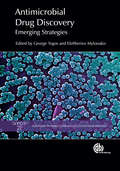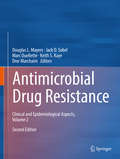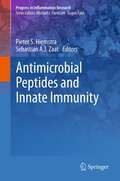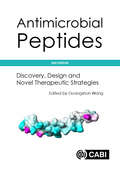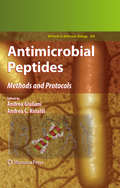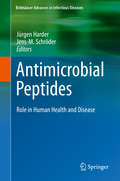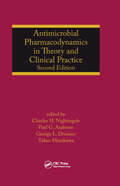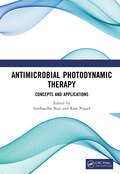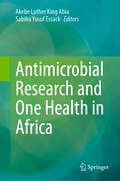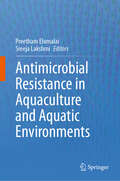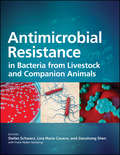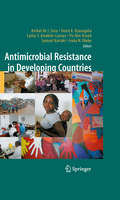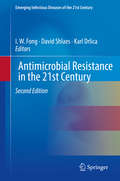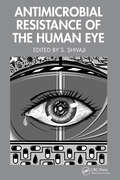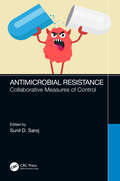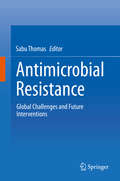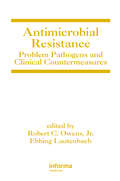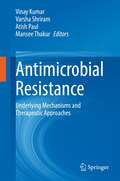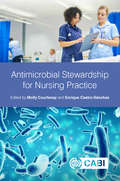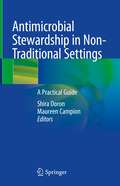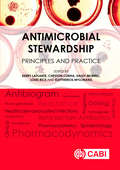- Table View
- List View
Antimicrobial Drug Discovery
by Eleftherios Mylonakis George Tegos Eliora Ron Arnold Demain Hattie GreshamDrug resistance is increasing among a variety of human pathogenic microorganisms such as Enterococcus faecium, Staphylococcus aureus, Klebsiella pneumoniae, Acinetobacter baumaniii, Pseudomonas aeruginosa and Enterobacter spp. (currently dubbed the 'ESKAPE' pathogens), and has emerged as one of the most important clinical challenges of this century. Increased general awareness and fear of these pathogens means there is a growing demand for research to tackle the threat of multidrug resistance. Documenting the latest research in the field, this book discusses current and promising activities to discover new antimicrobials in five key areas: molecular genetics and systems microbiology; synthetic, computational chemistry and chemoinformatics; High Throughput Screening (HTS); non-vertebrate model hosts; and light- and nano-based technologies.
Antimicrobial Drug Resistance: Clinical and Epidemiological Aspects, Volume 2 (Infectious Disease Ser.)
by Jack D. Sobel Douglas L. Mayers Marc Ouellette Keith S. Kaye Dror MarchaimThe two volumes included in Antimicrobial Drug Resistance, Second Edition is an updated, comprehensive and multidisciplinary reference covering the area of antimicrobial drug resistance in bacteria, fungi, viruses, and parasites from basic science, clinical, and epidemiological perspectives. This newly revised compendium reviews the most current research and development on drug resistance while still providing the information in the accessible format of the first edition. The first volume, Antimicrobial Drug Resistance: Mechanisms of Drug Resistance, is dedicated to the biological basis of drug resistance and effective avenues for drug development. With the emergence of more drug-resistant organisms, the approach to dealing with the drug resistance problem must include the research of different aspects of the mechanisms of bacterial resistance and the dissemination of resistance genes as well as research utilizing new genomic information. These approaches will permit the design of novel strategies to develop new antibiotics and preserve the effectiveness of those currently available. The second volume, Antimicrobial Drug Resistance: Clinical and Epidemiological Aspects, is devoted to the clinical aspects of drug resistance. Although there is evidence that restricted use of a specific antibiotic can be followed by a decrease in drug resistance to that agent, drug resistance control is not easily achieved. Thus, the infectious diseases physician requires input from the clinical microbiologist, antimicrobial stewardship personnel, and infection control specialist to make informed choices for the effective management of various strains of drug-resistant pathogens in individual patients. This 2-volume set is an important reference for students in microbiology, infectious diseases physicians, medical students, basic scientists, drug development researchers, microbiologists, epidemiologists, and public health practitioners.
Antimicrobial Drug Resistance: Mechanisms of Drug Resistance, Volume 1 (Infectious Disease Ser.)
by Jack D. Sobel Douglas L. Mayers Marc Ouellette Keith S. Kaye Dror MarchaimThe two volumes included in Antimicrobial Drug Resistance, Second Edition is an updated, comprehensive and multidisciplinary reference covering the area of antimicrobial drug resistance in bacteria, fungi, viruses, and parasites from basic science, clinical, and epidemiological perspectives. This newly revised compendium reviews the most current research and development on drug resistance while still providing the information in the accessible format of the first edition. The first volume, Antimicrobial Drug Resistance: Mechanisms of Drug Resistance, is dedicated to the biological basis of drug resistance and effective avenues for drug development. With the emergence of more drug-resistant organisms, the approach to dealing with the drug resistance problem must include the research of different aspects of the mechanisms of bacterial resistance and the dissemination of resistance genes as well as research utilizing new genomic information. These approaches will permit the design of novel strategies to develop new antibiotics and preserve the effectiveness of those currently available. The second volume, Antimicrobial Drug Resistance: Clinical and Epidemiological Aspects, is devoted to the clinical aspects of drug resistance. Although there is evidence that restricted use of a specific antibiotic can be followed by a decrease in drug resistance to that agent, drug resistance control is not easily achieved. Thus, the infectious diseases physician requires input from the clinical microbiologist, antimicrobial stewardship personnel, and infection control specialist to make informed choices for the effective management of various strains of drug-resistant pathogens in individual patients. This 2-volume set is an important reference for students in microbiology, infectious diseases physicians, medical students, basic scientists, drug development researchers, microbiologists, epidemiologists, and public health practitioners.
Antimicrobial Peptides and Innate Immunity (Progress in Inflammation Research)
by Sebastian A. Zaat Pieter S. HiemstraAntimicrobial peptides have been the subject of intense research in the past decades, and are now considered as an essential part of the defense system in bacteria, plants, animals and humans. his book provides an update on these effector molecules of the innate immune system both for researchers who are already actively involved in the area, and for those with a general interest in the topic. The book starts with an overview of the evolution of cysteine-containing antimicrobial peptides (including defensins), and the role of these peptides in host defense in plants and micro-organisms. The realization that antimicrobial peptides also display functions distinct from their direct antimicrobial action is the focus of the next chapters, and puts these peptides center stage in immunity and wound repair. Further chapters discuss the role of antimicrobial peptides in disease, by providing an overview of mechanisms in bacterial resistance to antimicrobial peptides and a discussion of their role in inflammatory bowel disease, cystic fibrosis lung disease and chronic obstructive pulmonary disease. Finally, the book shows how knowledge of the function of antimicrobial peptides and their regulation can be used to design new therapies for inflammatory and infectious disorders. This is a very important area of research because of the increase in resistance of micro-organisms to conventional antibiotics. Therefore the use of synthetic or recombinant peptides, or agents that stimulate the endogenous production of antimicrobial peptides, provides an attractive alternative for conventional antibiotics.
Antimicrobial Peptides: Discovery, Design and Novel Therapeutic Strategies
by Guangshun WangThis 18th in the series of Advances in Molecular and Cellular Microbiology, examines new technologies such as bioinformatics, combinatorial libraries, high-throughput screening, peptidomimetics, biophysics, and structural biology, in addition to covering the current advances in AMP research. This volume also describes new methods and strategies for AMP prediction, design, and applications that overcome obstacles in developing them into therapeutic agents.
Antimicrobial Peptides: Discovery, Design and Novel Therapeutic Strategies
by Guangshun WangAntimicrobial peptides (AMPs) have attracted extensive research attention worldwide. Harnessing and creating AMPs synthetically has the potential to help overcome increasing antibiotic resistance in many pathogens. This new edition lays the foundations for studying AMPs, including a discovery timeline, terminology, nomenclature and classifications. It covers current advances in AMP research and examines state-of-the-art technologies such as bioinformatics, combinatorial libraries, high-throughput screening, database-guided identification, genomics and proteomics-based prediction, and structure-based design of AMPs. Thoroughly updated and revised, this second edition contains new content covering: defensins; cathelicidins; anti-MRSA, antifungal, antiviral, anticancer and antibiofilm strategies; combined treatments; adjuvants in vaccines; advances in AMP technologies that cover surface coating to prevent biofilm formation; nanofiber encapsulation technologies for delivery and sustained release; and understanding innate immunity and the basis for immune boosting to overcome obstacles in developing AMPs into therapeutic agents. Written and reviewed by a group of established investigators in the field, Antimicrobial Peptides is a valuable resource for postgraduate students, researchers, educators, and medical and industrial personnel.
Antimicrobial Peptides: Discovery, Design and Novel Therapeutic Strategies (Advances In Molecular And Cellular Microbiology Ser.)
by Guangshun WangAntimicrobial peptides (AMPs) have attracted extensive research attention worldwide. Harnessing and creating AMPs synthetically has the potential to help overcome increasing antibiotic resistance in many pathogens. This new edition lays the foundations for studying AMPs, including a discovery timeline, terminology, nomenclature and classifications. It covers current advances in AMP research and examines state-of-the-art technologies such as bioinformatics, combinatorial libraries, high-throughput screening, database-guided identification, genomics and proteomics-based prediction, and structure-based design of AMPs. Thoroughly updated and revised, this second edition contains new content covering: defensins; cathelicidins; anti-MRSA, antifungal, antiviral, anticancer and antibiofilm strategies; combined treatments; adjuvants in vaccines; advances in AMP technologies that cover surface coating to prevent biofilm formation; nanofiber encapsulation technologies for delivery and sustained release; and understanding innate immunity and the basis for immune boosting to overcome obstacles in developing AMPs into therapeutic agents. Written and reviewed by a group of established investigators in the field, Antimicrobial Peptides is a valuable resource for postgraduate students, researchers, educators, and medical and industrial personnel.
Antimicrobial Peptides: Methods and Protocols (Methods in Molecular Biology #618)
by Andrea Giuliani Andrea C. RinaldiThe action of antimicrobial peptides (AMPs), ranging from direct killing of invading pathogens to immune response modulation and other complex biological responses, has stimulated research and clinical interest for more than two decades, but the area is still burgeoning due to emerging discoveries in the functions, roles, and regulation of AMPs, thus making the study of antimicrobial peptides a multi-disciplinary and rapidly evolving field. In Antimicrobial Peptides: Methods and Protocols, leading investigators present a broad, up-to-date collection of current research and experimental methods for the isolation, characterization, production, and optimization of antimicrobial peptides. Additional chapters detail methodologies in several microscopy techniques, high-throughput screening, QSAR modeling, and computer-aided design used to study these compounds, while key review articles survey potential medical applications of antimicrobial peptides as innovative anti-infective and immunomodulatory agents, as well as emerging discoveries in their function, regulation, and roles in innate immunity. As a volume in the highly successful Methods in Molecular BiologyTM series, chapters include introductions to their respective topics, lists of the necessary materials and reagents, step-by-step, readily reproducible laboratory protocols, and notes on troubleshooting and avoiding known pitfalls. Authoritative and wide-ranging in its applications, Antimicrobial Peptides: Methods and Protocols provides both an authoritative guide for lab work on AMPs or related substances and a useful collection of thought stimuli to inspire further scientific endeavours in a wide array of vital fields.
Antimicrobial Peptides: Role in Human Health and Disease (Birkhäuser Advances in Infectious Diseases)
by Jürgen Harder Jens-M. SchröderThis book focuses on the importance of human antimicrobial peptides (AMP) in keeping the host healthy and preventing infectious diseases. The first chapters deal with several examples of the role of AMP in different epithelial organs (skin and wound healing, eye, lung, genito-urinary tract, gut), which are exposed to different kinds of infectious microorganisms and as a result produce different patterns of AMP. Examples of the dysregulation of AMP expression and function promoting infections are discussed. The capacity of AMP to restrict the availability of essential metals to bacteria as an efficient antibacterial strategy in nutritional immunity is discussed in the next chapter. Our current understanding of how vitamin D, the sunshine vitamin, influences AMP-expression and how this can affect our health is also addressed. Last but not least, the role of AMP in HIV infection and the immunomodulatory properties of AMP highlight the diverse facets of AMP in host immunity. AMP's specific functions, including in fighting multi-resistant bacteria, suggest that they may offer therapeutic benefits - a question that is discussed in the final chapter.
Antimicrobial Pharmacodynamics in Theory and Clinical Practice
by George L. Drusano Takeo Murakawa Charles H. NightingaleTaking readers from the research laboratory to the bedside, this Second Edition compiles essential information on the pharmacodynamics of all major classes of the antimicrobial armamentarium including penicillins, cephalosposorins, cephamycins, carbapenems, monobactams, aminoglycosides, quinolones, macrolides, antifungals, antivirals, and emerging
Antimicrobial Photodynamic Therapy: Concepts and Applications
by Ram Prasad Siddhardha BusiAntimicrobial Photodynamic Therapy: Concepts and Applications explores the novel antimicrobial therapeutic technique. As the world searches for new, efficient modalities for fighting microorganisms, this book offers a complete understanding of the concept, and knowledge about the emerging technique ‘antimicrobial photodynamic therapy’ (aPDT) for the scientific communities and budding researchers. The book aligns concepts, significance, and applications of the technique systematically. Chapters in the book cover microorganisms, pathogenesis, conventional treatment methods, and significance of new treatment approaches to the concept of antimicrobial photodynamic therapy. The authors describe the mechanism behind it, with applications and examples from research studies. The book discusses photosensitisers in detail, with one chapter emphasising natural photosensitisers. Use of nanostructures in the antimicrobial photodynamic therapy is elaborated on, and we conclude with a well-explored application of the therapeutic technique in dentistry. Features: Efficiently covers the topic in detail with scientifically proven examples. Applications of the therapeutic approach are well discussed, and readers can learn about the research gaps, challenges, and future of the technique. Starts from basics, enabling readers to understand why the approach is relevant and important for study. Simplistic elucidated concepts and applications make it accessible at all levels.
Antimicrobial Research and One Health in Africa
by Akebe Luther King Abia Sabiha Yusuf EssackAntimicrobial resistance is recognised among the world’s most challenging problems. Despite its global spread, Africa, specifically sub-Saharan Africa, is the most affected by this malaise. Poor living conditions and inadequate access to sanitation and potable water supplies are among contributing factors that have influenced a high disease burden on the continent, requiring extensive antimicrobials. Weak health systems and the absence of firm policies further aggravate the problem, as the use of antimicrobials is mostly unregulated. The increasing demand for animal protein to meet the starving populations’ demands has also influenced the use of these antimicrobials, including those banned on other continents, for food animal production. The ripple effect of indiscriminate use in humans and animals is the massive discharge of antimicrobials, their residues, antimicrobial-resistant microorganisms and their associated genes into the environment. This 14-chapter unique masterpiece presents the AMR problem in African, addressing the various compartments of the One Health – humans, animals, and the environment, to illustrate the need for concerted efforts in the fight against AMR, especially in Africa. Authors from the four cardinal points present diverse aspects of AMR in Africa, starting with behavioural and social drivers of AMR in Africa. Antimicrobial stewardship in an African context is also discussed. AMR in humans is presented through studies on antibiotic-resistant neonates and nontyphoidal Salmonella infections and the clinical relevance of the genetics of viral resistance. Topics on AMR in mastitis, biosecurity in animal farming and the linkage between disinfectants and AMR are discussed. The environmental dimension of AMR is discussed, notably in the aquatic environment, and its implication for aquaculture and irrigation and using nanomaterials to treat polluted waters from such environments are highlighted. Finally, Africa’s rich floral diversity is portrayed as an eco-friendly and cost-effective approach to combat AMR. Hopefully, the work presented will spur greater collaboration between scientists, environmental, animal and human health practitioners, the general population, and policymakers to assimilate and implement the One Health approach to combating AMR, rather than working in silos on their various sectors
Antimicrobial Resistance in Aquaculture and Aquatic Environments
by Preetham Elumalai Sreeja LakshmiThis book provides the latest information on aquatic AMR from the perspective of inflammation and presents new ideas on the complicated mechanisms of lectin biochemistry and associated interactions. Key features include discussion of mechanisms recently identified to be involving surveillance and monitoring of AMR and AMU, presentation of the latest evidence regarding the molecular approaches in disease therapeutics, and thorough explanation of the concept of one health challenges and current understanding of the significance of its disease resistance related studies. Gene expression studies is another important element of the book, and it is proposed that gene editing technology provides gaining attention in the biological role of fresh water and marine environments. Examples of the many latest molecular approaches, applications and future perspectives in AMR specific topics covered in this book include the information right from the basics to the advancements in this area. The book will be a valuable update and resource for both experienced and younger researchers working in the field of marine biology and immunology.
Antimicrobial Resistance in Bacteria from Livestock and Companion Animals (ASM Books)
by Stefan Schwarz Jianzhong Shen Lina CavacoThe global spread of antimicrobial-resistant pathogenic bacteria is a continuing challenge to the health care of humans and domesticated animals. With no new agents on the horizon, it is imperative to use antimicrobial agents wisely to preserve their future efficacy. Led by Editors Stefan Schwarz, Lina Maria Cavaco, and Jianzhong Shen with Frank Møller Aarestrup, an international team of experts in antimicrobial resistance of livestock and companion animals has created this valuable reference for veterinary students and practitioners as well as researchers and decision makers interested in understanding and preventing antimicrobial resistance.
Antimicrobial Resistance in Developing Countries
by Samuel Kariuki Carlos F. Amábile-Cuevas Po-Ren Hsueh Iruka N. Okeke Denis K. Byarugaba Aníbal De SosaToday, there is considerable literature regarding the subject of antimicrobial resistance. However, most of this information is based on information from developed countries. Very little organized information is available about the subject that critically examines the problem in developing countries. Scattered literature is available in various forms in journals that are often not easily accessible to the affected developing countries. The objective of the book is to put together data and information about the problem of antimicrobial resistance in developing countries addressing the general global perspectives, the risk factors, the current rates, trends, and possibilities for containment as they relate to specific conditions in those developing countries.
Antimicrobial Resistance in the 21st Century (Emerging Infectious Diseases of the 21st Century)
by I. W. Fong David Shlaes Karl DrlicaThis comprehensive, up-to-date volume defines the issues and offers potential solutions to the challenges of antimicrobial resistance. The chapter authors are leading international experts on antimicrobial resistance among a variety of bacteria, viruses including HIV and herpes, parasites and fungi. The chapters explore the molecular mechanisms of drug resistance, the immunology and epidemiology of resistance strains, clinical implications and implications on research and lack thereof, and prevention and future directions.
Antimicrobial Resistance of the Human Eye
by S. ShivajiThe book covers antimicrobial resistance in ocular diseases, including the microbiology of the ocular surface, the history and origin of antimicrobials, methods to detect antimicrobial resistance and antimicrobial resistance genes, and the impact of antimicrobial resistance on a variety of ocular diseases. The inclusion of chapters covers bacterial keratitis, fungal keratitis, viral keratitis, acanthamoeba keratitis, endophthalmitis, dry eye disease, post fever retinitis, and uveitis including management and prevention of antimicrobial resistance.Key Features: Focusses on various ocular diseases and their association with antimicrobial resistance; Includes data relevant to drug industry to develop drugs for specific ophthalmic use; Illustrates ocular surface microbiome under various diseased condition;s Highlights the microbes associated with the conjunctiva and cornea of the human eye; Enumerates the changes in the abundance and diversity of the antimicrobial resistant (AMR) microorganisms in the diseased eye. This book is aimed at professionals and researchers in ophthalmology, microbiologists, infectious disease specialists, and public health.
Antimicrobial Resistance: Collaborative Measures of Control
by Sunil D. SarojAntimicrobial resistance has existed in nature long before the discovery of antibiotics. The mechanisms of resistance are prevalent among the bacterial population. Over a period of time and facilitated by indiscriminate usage of antibiotics, these mechanisms are transferred from one type of bacteria to another, including the pathogenic ones. In addition, the rate of discovery of novel antimicrobials is much slower than the rate of evolution of antimicrobial resistance. Therefore, there is a need for alternative strategies to control antimicrobial resistance to save lives. In this book, the novel strategies to combat antimicrobial resistance are described, emphasizing collaborative measures of control. We describe the concerted efforts undertaken by global communities to combat antimicrobial resistance in detail. The most efficient strategy could be a behavioral change towards indiscriminate consumption, usage, and prescription of antibiotics.
Antimicrobial Resistance: Global Challenges and Future Interventions
by Sabu ThomasAntimicrobial resistance is a major global public health problem. This book focuses on the clinical implications of multi-drug resistant pathogens; tracking AMR and its evolutionary significance; antifungal resistance; and current and alternative treatment strategies for AMR, including antivirulent, antibiofilm and antimicrobial resistance breakers, repurposing of drugs, and probiotic therapy. Advances in antimicrobial stewardship, antibiotic policies from a global perspective and their impacts are also discussed. The book also explores the use of omics approaches to gain insights into antibacterial resistance, and includes chapters on the potential benefits of a ‘One Health approach’ describing the environmental and zoonotic sources of resistant genes and their effects on the global resistance pool.
Antimicrobial Resistance: Omics and Systems Biology Approaches
by Vijay Soni Ajay Suresh AkhadeAntimicrobial resistance (AMR) is increasing globally at an incredible rate, and many infectious diseases have already reached an alarming stage of resistance to existing treatments. WHO reports that nearly1.27 million people currently die each year due to resistant infections, and AMR is projected to account for 10 million annual deaths globally by 2050. There is an urgent need for novel approaches to address this issue. Omics technologies are powerful research tools used extensively to study pathogen biology and the activity of microbial agents. These tools, paired with systems biology approaches, can provide novel insights into antimicrobial susceptibility and resistance, and aid in the development of new, more effective measures to combat resistant pathogens. This book provides a comprehensive overview of omics technologies to study pathogen biology, including proteomics, genomics, transcriptomics, metabolomics, and microbiome analysis, and the role of systems biology in developing strategies to combat resistant pathogens. It addresses environmental reservoirs and mobile genetic agents in AMR, host-pathogen interactions and physiology in the development of resistance, drug repurposing and development, and cutting-edge tools such as machine learning, AI for big data analysis, and genomic surveillance. The final section discusses future perspectives on omics-systems biology in AMR, and identifies opportunities for scientific collaboration in the global fight against antimicrobial resistance. This book serves as a comprehensive and accessible resource for researchers in academia and industry focused on immunology, drug development, biotechnology, and systems biology.
Antimicrobial Resistance: Problem Pathogens and Clinical Countermeasures (Infectious Disease And Therapy Ser. #Vol. 48)
by Jr. Ebbing Lautenbach Robert C. OwensThis publication provides a state-of-the-art overview of key issues related to antimicrobial resistance, including a focus on key pathogens causing common healthcare-associated and community-acquired infections. The epidemiology and therapeutic considerations of these antimicrobial resistant organisms are discussed, as well as the clinical and heal
Antimicrobial Resistance: Underlying Mechanisms and Therapeutic Approaches
by Vinay Kumar Varsha Shriram Atish Paul Mansee ThakurAntimicrobial resistance (AMR) is a global public health threat that needs immediate attention and action from the scientific community. This book compiles and presents the latest and most important aspects of AMR, including the biology involved, its persistence and spread, and novel approaches to tackle this threat. The book first describes the mechanisms and spread of AMR, and then discusses the various approaches and strategies for combating it. Important topics include, microbial pathogenesis, AMR traits and major mechanisms underlying drug-resistance and the emerging strategies and technologies for combating AMR. Emphasis has been given on current developments about natural products including potent phyto-molecules, antimicrobial peptides and endophytes effective against the drug-resistant microbes and target the main drug-resistance determinants (efflux pumps, biofilms, quorum sensing, plasmids, etc.) in these bacterial pathogens. Other exciting topics include applications of nanomaterials in tackling AMR and CRISPR-Cas based precise sequence-specific antimicrobials. This informative book is meant for students and researchers in basic and medical microbiology and biotechnology. It is also useful to public health professionals and industry experts involved in AMR research and related drug-designing.
Antimicrobial Stewardship for Nursing Practice
by Heather Kennedy Briette Du Toit Yolanda Van Zyl Maria Clara Padoveze Ligia Maria Abraão Rosely Moralez Figueiredo Jo McEwen Nykoma Hamilton Emma Burnett Valerie Ness Fiona Gotterson Prof Elizabeth Manias Rose Gallagher Rita Olans Susie Singleton Joanne BosanquetDrug-resistant infections are one of the greatest threats to human health, and with resistance on the rise, appropriate antimicrobial stewardship (AMS) is more important than ever. This book, written by nurses for nurses, provides a clear and concise approach to good practice in this vital area. Exploring all aspects of AMS, this new book is underpinned by a competency framework endorsed by scientific and professional societies, including the National Institute for Health and Care Excellence (NICE). It explains the practices that ensure optimal use of antibiotics for the best clinical outcome, with both minimal toxicity to the patient and minimal impact on subsequent antimicrobial resistance. This book, the first applied directly to antimicrobial stewardship for nurses, supports standards of proficiency for registered nurses, and can therefore be used by regulators and professional bodies to inform standards of proficiency and guidance. The book covers infection prevention and control, antimicrobial resistance, diagnosis of infection and appropriate antimicrobial use, patient engagement, collaboration between professions and how to implement AMS in nursing practice. Including learning tools such as objectives, practical case studies and questions throughout, as well as lecture slides, this book is an essential read for undergraduate nursing students and specialist nurses worldwide. This book is authored by a multi-national group of experts with representation from professional associations, universities and national public health agencies, such as: - Royal College of Nursing, UK - Cardiff University, UK - University of São Paulo, Brazil - Public Health England, UK - National Centre for Antimicrobial Stewardship, Australia
Antimicrobial Stewardship in Non-Traditional Settings: A Practical Guide
by Shira Doron Maureen CampionThe evolution of Antimicrobial Resistance is outpacing the ability to create novel antibiotics, which is proving to be a global problem in the fact of climate change, population growth, demographic shifts toward aging populations, emerging infections, and other crises. Therefore, clinicians are forced to use the existing antimicrobials more responsibly to preserve their longevity for generations to come. In a parallel vein, there has been a recent regulatory acknowledgement of the importance of prudent antimicrobial prescribing, mandating the implementation of Antimicrobial Stewardship across all healthcare settings. This is harder to manage in a non-traditional setting, which include long-term care facilities, outpatient care clinics, urgent care centers, and others. Given the trends in patient care in these settings—particularly where the aging community is concerned—this is proving to be a growing problem. This is troublesome even for spaces that have university and large hospital affiliations. There is a plethora of data describing the implementation and outcomes of Antimicrobial Stewardship Programs in acute-care hospitals with open-access, evidence-based guidelines endorsed by the Infectious Diseases Society of America. However, non-traditional settings often find themselves struggling to implement the same practices and procedures due to their unique needs and limited resources. There may be variability in access to resources, applicability, and patient-type. This book seeks to inform those in non-traditional healthcare settings on the principles, practice, and outcomes of Antimicrobial Stewardship Programs to improve patient care across all settings. The text begins by unpacking Antimicrobial Stewardship in nontraditional settings then covers specific environments, including long-term care facilities, outpatient clinics, and emergency departments. The text also covers special topics, including veterinary medicine, HIV, oncology, and immunocompromised patients, pediatrics, neonates, transplant, and critical care patients.
Antimicrobial Stewardship: Principles and Practice
by Thomas Lodise John McNelis Powel Kazanjian Armen Arshakyan Cesar Arias Allison H. Bartlett Dr Andrew Berti April Bobenchik Hugh Booth Carey-Ann Burnham Michael Calderwood Dr Gerald Capraro Professor Joseph Carreno Kimberle Chapin Dr Christopher W Crank Robert S. Daum Professor Susan Davis George Daikos Dr Tom Dilworth Christopher D Doern Professor Gary V Doern Curtis Donskey Monica Dorobisz Ramy Elshaboury Sandy Estrada Dr Islam Ghazi Dr Jennifer Goldman Dr Blanca Gonzalez Dr Christopher J Graber Inge Gyssens Sajeev Handa Dr Amy Hanson Emily L Heil Elizabeth D Hermsen Styliani Karanika Keith S Kaye Dr Joseph L Kuti Dr Nicole M Mahoney Antonis Markogiannakis Dr Aileen Martinez Dr Dmitriy Martirosov Dr Dayna McManus Renee-Claude Mercier Dr Jacob Morton Dr Jose M Munita Dr Jason Newland Dr David Nicolau Dr Jessica Ortwine Dr Suresh Paudel Dr Jason Pogue Dr Warren Rose John Rotschafer Dr Michael Ruggero Dr Michael Samarkos Nikolaos Sipsas Harold Standiford Dr Melvin Stone Jr Dr Mahlet Tadele Evangelia Theophano Piperaki Dr Philip Toltzis Dr Jeffrey E Topal Damary Torres Leonidas Tzouvelekis Jamie L Wagner Carla Walraven Panayiotis ZiakasIn an age where antimicrobial resistance amongst pathogens grows more prevalent, particularly in the hospital setting, antimicrobial stewardship is an evidence-based, proven measure in the battle against resistance and infection. This single comprehensive, definitive reference work is written by an international team of acknowledged experts in the field. The authors explore the effective use of coordinated antimicrobial interventions to change prescribing practice and help slow the emergence of antimicrobial resistance, ensuring that antimicrobials remain an effective treatment for infection. Amongst the first of its kind, this book provides infectious disease physicians, administrators, laboratory, pharmacy, nursing and medical staff with practical guidance in setting up antimicrobial stewardship programs in their institutions with the aim of selecting the optimal antimicrobial drug regimen, dose, duration of therapy, and route of administration.
